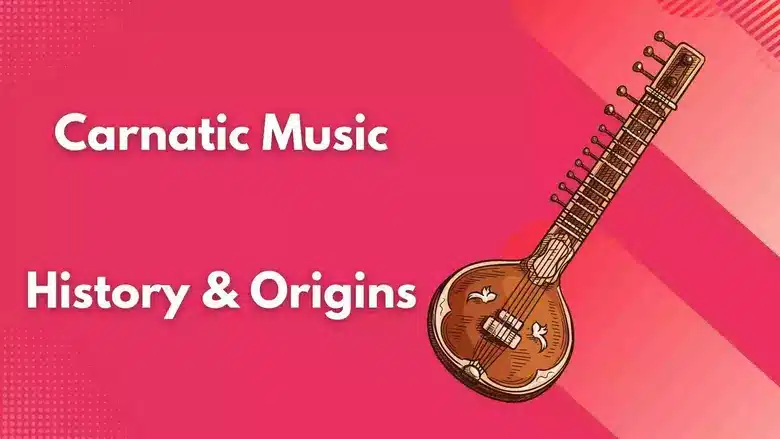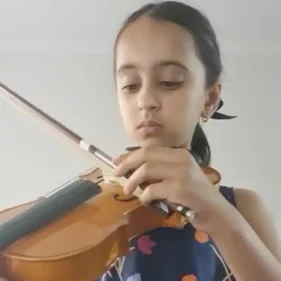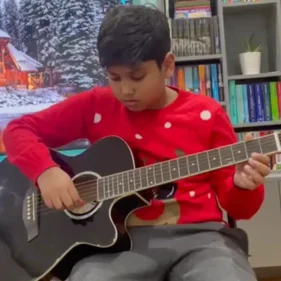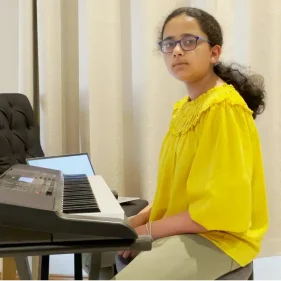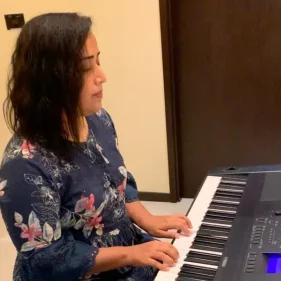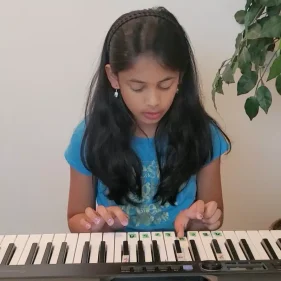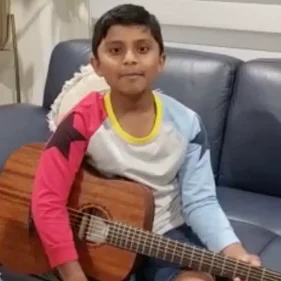- Carnatic Music Origins – History
- Vedic Period – 4th Century : Ancient Period
- 5th – 16th Century: Medieval Period
- 17th Century Period
- 18th Century Period: Trinity of Carnatic Music
- 19th Century Period
- After the 20th Century Period
- What are some of the most popular Carnatic music compositions and songs?
- What are the elements of Carnatic music?
- How can you learn more about Carnatic Music?
- Conclusion
Carnatic music, or Karnataka Sangitam, is one of the oldest and most popular forms of Indian classical music. This music originated in South India and has since spread throughout the world. It focuses on melody and rhythm rather than harmony. It is one of the oldest and most complex forms of classical music globally. Though it may be unfamiliar to many listeners outside of India, Carnatic music is worth exploring for its unique qualities and complex structures. The genre features an intricate system of ragas (melodic modes), talas (rhythmic patterns), and swaras ( vocal or instrumental notes).
In this article, we will explore the history and elements of Carnatic music and learn about some of the most famous Carnatic musicians. If you’re curious about this fascinating style of music, continue reading!!
Carnatic Music Origins – History
Did you know that the history of carnatic music dates back over two thousand years?
Carnatic music is one of the oldest and most distinguished forms of classical Indian music. It is a vocal-centric genre that features elaborate compositions with a wide range of emotional expressions.
Carnatic music’s ancient theory is thought to be originated from divine. Lord Shiva, also known as ‘Nada Brahma’ or ‘the God of Sound, is the patron deity of Carnatic music. Carnatic music’s foundational texts were composed during the Vedic periods. It laid the groundwork for this unique and great musical tradition that has withstood the test of time. It has evolved and been influenced by numerous styles over the centuries. That made it one of the most diverse forms of Indian classical music. Today, Carnatic music continues to be an integral part of Indian culture, enjoyed by millions of people across the country.
Music has been a captivating human experience since the very beginning of time. Hindu scholars believe that Vedic scriptures gave birth to music through their ancient hymns. The folk melodies from across India continue to carry their tradition forward even now. From these ritual songs of devotion, Carnatic and Hindustani styles emerged. Each borrows elements from the other while maintaining their own unique identities along the way.
Vedic Period – 4th Century : Ancient Period
Music has been a part of human culture since before written history, yet the precise origins are unknown. Some believe that musical instruments originate from divine sources like gods and goddesses. Some suggest that nature inspires music, as each ‘Swara’ (musical note) may come from animals or birds.
Carnatic Music began to take shape during a crucial era in Indian music history.Generations have passed down the ancient Hindu tradition of the Vedas through an oral history. At its core, “Veda” translates to knowledge.The four Vedas – Rig Veda, Yajus Veda, Sama Veda and Atharvana – comprise the Vedic literature. It is believed that Sama was instrumental in laying the foundations for Indian music.
The Vedas are the oldest source of musical references in India, with Rik Pratisakya and Panini (400 BC) being one of its earliest mentions. The Brihadaranyaka Upanishad discusses the theories of seven notes from three original ones and musical instruments such as Veena, Flute and Damru.
Additionally, the Ramayana and Mahabharata are known for their many findings related to music. According to the ancient Natyasastra written by Bharata, music was initially associated with the Gandharvas – an Aryan semi-divine race of beings described in Hindu mythology.
Bharata’s Natya Shastra is a foundational document for the study of music and dance, offering insight into ancient melodies (Jaatis), instruments, notes (swaras) varieties, combinations(varnas), and more. He classifies Swara, Tala and pada as the three pillars of Indian Classical Music, referred to as Marga. Additionally, it shines a light on Tamil music developed by native Dravidians in South India around that time.
The traditional art of music in South India has its roots deep within the ancient history of Tamil culture, with evidence found in literature such as Silappadikaram and Tolkappiam.
5th – 16th Century: Medieval Period
From the 6th to 7th centuries, a crucial period in music history, advancement was well documented by scholars and composers, leading to an unprecedented evolution of musical concepts. The earliest mention of ‘Raga’, for example, is found within Matanga’s literary work Brihaddesi, which also provides names and structures for significant Ragas and a rudimentary classification system that was instrumental in fostering independent art forms not dependent on dance or drama performances.
The Kudimiyanmalai inscriptions in a cave near Pudukottai (Tamilnadu) are a collection of musical notations from the 7th century A.D. They provide an impressive glimpse into early South Indian music. Tevarams from the 6th – 9th centuries are famous even today because they include over twenty Carnatic scales named after Tamil terms. Divya Prabandham, a set of works created by Vaishnavite Azhwars during the same era, continue to influence modern-day Carnatic music. This period is a crucial source of contributions from Tamil-speaking regions throughout history.
Arunagirinathar’s Tiruppugazh, composed in the 15th century, is an iconic Tamil work of art that has had a powerful influence on Carnatic music. The complex and captivating rhythmic meters remain impressive centuries later. Almost two hundred years earlier, Jayadeva wrote Gita Govinda, another colossal piece in Sanskrit. It contained 24 songs with varying melodies set to different Ragas. This was one of the first examples resembling what we consider regular musical composition. Its Ashtapadis (eight-footed) structure is still prevalent and celebrated throughout India, even though the original tunes have been lost over time.
Sarngadeva
Sarngadeva, an influential scholar of the 13th century, wrote a comprehensive treatise on Indian music renowned for its immense influence in both Hindustani and Carnatic traditions. This work contains five thousand Sanskrit couplets divided into nine chapters detailing Swaras, Ragas, Prabandhas (musical form), Tala-vaidyas (percussion instruments), and Gamakas (ornamentations), amongst other aspects. It is considered one of the most prolific musical works between Brihaddesi’s compositions and the Sangeeta Ratnakara period, as it outlines the Desi system. This transitionary phase provided the basis for two distinct genres known today.
Sarngadeva’s work was an influential spark for the later scholars who wrote seminal musicological texts. Notably, Vidyaranya’s Sangeeta Sara in the 14th century set a landmark by introducing Melas (Parent) and Janya ragas as musical classifications. After this breakthrough, however, there seems to have been a gap of almost two centuries until Ramamatya. He made his contribution through Swaramela Kalanidhi in In 1550 A.D. Ramamatya was Ramaraya’s contemporary from Vijayanagara.
Creative musical compositions
Music in India has undergone a long and fascinating evolution, from the ancient Gandharvagana forms of Bharata’s period to the present-day Prabandhas. During this time, several exciting genres were composed, such as Tevaram, Divyaprabandham, Tiruppavai (part of Divayprabandham), Ashtapadis, Padams Kritis, Gitams along with Abhyasa Gana for beginner-level students. Tallapakkam Annamacharya, 15th century contributed by introducing a new form called ‘Kriti’, which had three sections: Pallavi, Anupallavi and Charanam. This soon became popular among many composers, especially those of the musical dynasty known as Trinity and continues to be widely accepted today.
Indeed by the medieval period, Carnatic Music had achieved its distinct character built on strong musical roots from long ago.
17th Century Period
Entering the 17th century, Carnatic music experienced an incredible surge of development that further enhanced its already-rich tradition. Composers throughout this period did detailed writings on the theory and practice of the art form. Its heritage would be preserved for future generations.
Venkatamakhi revolutionized the practice of classical Indian music with his composition, the 72 Melakarta scheme. This formative treatise was established in 1660 AD and was a foundational cornerstone of our musical heritage. It is an illustrious display of academia and has tangible benefits for musicians, scholars and learners alike.
Furthermore, other important works from this time include:
Sangeeta Saramrita by Tulaja (1729-1735), Sangeetha Sudha written by Govinda Dikshita and Sangraha Choodamnani created by Mittanjali Lal Mohania.
18th Century Period: Trinity of Carnatic Music
Carnatic music experienced a burst of creativity in the late 18th century when its three great composers were born. These venerated figures are now known as The Musical Trinity (Trimurti): Syama Sastri (1762 – 1827), Tyagaraja (1767-1847) and Muthuswami Dikshitar(1776-1835). These pioneering composers elevated musical composition to unparalleled heights through their combination of immense knowledge and spirituality with innovative ideas. Their contributions have been valuable for generations that followed them. They inspired many other eminent musicians who furthered the Carnatic repertoire by adding superbly composed pieces.
19th Century Period
By the turn of the 19th century, groundbreaking developments in written notation had emerged to represent musical compositions accurately. Notable figures Subbarama Dikshitar and Manikka Mudaliar published well-known works like Sangeeta Sampradaya Pradarsini (Telugu) and Sangeeta Chandrikai (Tamil). At the same time, A M Chinnasami Mudaliar redefined South Indian music through western staff notation. These acclaimed pioneers have laid a foundation for further research into this extraordinary art form’s complexities.
Venkatamakhi’s 72 Melakraarta scheme, formulated in his 1660 treatise Chaturdandi Prakasika is a treasured part of our musical heritage. This cherished system has academic appeal and real-world practicality for musicians, musicologists and students alike.
Other essential writings from this period include :
Tulaja’s Sangeeta Saramrita (1729 – 1735 AD), Govinda Dikshita’s Sangeeta Sudha and the Sangraha Choodmani by Govinda (1750 AD).
Advancing into the 19th century, innovators such as Subbarama Dikshitar and Manikka Mudaliar created written notational schemes to capture musical compositions. A M Chinnasami Mudaliar then made a significant breakthrough by publishing South Indian pieces. He used western staff notation – opening new avenues for research on this captivating art form.
After the 20th Century Period
Carnatic music has continued to evolve in the 20th and 21st centuries, with modern-day composers. This contributes to this majestic art form. One of the greatest Carnatic vocalists of all time, M Balamuralikrishna (1930-2016), is an acclaimed figure. He left a lasting legacy as a singer, composer and teacher. Worldwide admirers praised him for his meticulous research into Carnatic music’s complexities and his innovative approach to traditional compositions.
Other notable contemporary figures are violin maestro Lalgudi Jayaraman (1930-2013), vocal virtuoso T M Krishna (b. 1970) and mandolin maestro U Srinivas (1969-2014).
What are some of the most popular Carnatic music compositions and songs?
Carnatic compositions are typically based on ragas or melodic scales. It has a lot of complicated gamakas, or ornamental embellishments, all over it. Many Carnatic songs also have lyrics in Sanskrit or Tamil, which makes them both beautiful and spiritually uplifting, making them even more beautiful. Some of the most popular Carnatic compositions include “Bhajan Tho Samaroham” by Muthuswami Dikshitar and “Kurai Onrum Illai” by MS Subbulakshmi.
Several Carnatic music compositions are trendy among audiences. One of these is the raga Māraranjani, often performed at weddings and other special occasions. Another famous Carnatic composition is the raga Kapi, known for its soothing and relaxing qualities. Other Carnatic compositions include:
- Those who listen to Raga Sindhu Bhairavi say it has an air of serenity and dedication to it.
- Raga Mohanam is a well-known bhajan. It is known for its beautiful melody and religious lyrics.
- In terms of tempo, Rage Hamsadhwani is renowned.
- Optimistic and joyous, Raga Shree has long been a favorite of audiences.
If you’re new to Carnatic music, an excellent place to start is with some of the most popular Carnatic compositions. These include works such as “Misra Chapu Thillana” by Muthuswami Dikshitar, “Raghupathi Raghava Rajaram” by Thyagaraja, and “Sindhu Bhairavi” by Muthaiah Bhagavathar.
What are the elements of Carnatic music?
The essential elements of Carnatic music are sruti (the smallest unit of pitch), Swara (musical note), raga (melodic mode), and tala (rhythmic cycle).
Sruthi
Sruthi is the smallest unit of pitch, and Carnatic music is based on a system of 72 sruthis. To understand Carnatic music, one must first understand Sruthi. In general, Sruthi refers to the pitch of a note that prescribes the tonal framework for a raga or melodic scale. Each swara in a raga has its determined sruthi. The concept of Sruthi plays a vital role in Indian classical music, especially in Carnatic music. A good singer will always try to sing in perfect sruthi to enrich the aesthetics of the performance. A beginner will find it difficult to understand and sing in perfect sruthi. But with some guidance and regular practice, it is not impossible to master the art.
Swara
Swara is the basic unit of this music, and it refers to the seven musical notes that form the octave. These notes are shadjam, rishabham, gandharam, madhyamam, panchamam, dhaivatham, and nishadham. Carnatic compositions are typically based on a particular raga, a melodic mode that uses a specific combination of these swaras.
Raga
Raga is probably the most crucial element in this music, as it defines the melodic framework for a composition. Each raga has a specific set of notes and a unique melodic contour. Melodic instruments such as the violin and veena are used. That allows the performer to show off the intricate melodic patterns of the raga.
Tala
Tala is the other key element of this music and defines the rhythmic framework of the composition. There are various talas, each with its unique character. The most common tala in this music is the Adi tala.
Carnatic music is a complex and rich musical tradition with a vast repertoire of compositions to explore. If you’re new to this genre, why not start by checking out our Carnatic music classes? Our method of teaching will surely impress you.
How can you learn more about Carnatic Music?
Carnatic music is based on complex rhythms and intricate patterns. As a result, this music can be pretty challenging to learn. However, there are a few things that you can do to make the process a bit easier.
- First, listening to as much Carnatic music as possible is essential. It will help you familiarise yourself with the different rhythms and tones used in this type of music.
- You can learn music by attending music courses, seminars or by watching tutorials online. The concerts, recordings, and reading on the history and philosophy of this music are now available for your consumption. Attend a Carnatic musician’s performance or take instruction from one of their students.
- Additionally, it would help if you tried to find a good teacher who can give you guidance and feedback on your playing or singing skills.
- Be patient and practice regularly. Learning this music takes time and dedication, but the rewards are well worth the effort.
Conclusion
Carnatic music is a beautiful and intricate form of classical Indian music. Today, Carnatic music enjoys a wide following all over the world, and there are many talented musicians who continue to perpetuate its legacy. Though it may seem complex at first glance, with a little bit of practice, anyone can learn to appreciate and enjoy this unique form of music. In this article, we have explored the history and elements of Carnatic music and some of the most famous Carnatic musicians. We hope you’ve enjoyed learning about this unique style of music. If you are unsure about where to start, approach a professional Carnatic musician. Thank you for reading!

